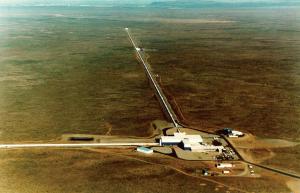LIGO
LIGO is the Laser Interferometry Gravitational-Wave Observatory. It detects gravitational waves from the surface of Earth. LIGO consists of 2 detectors: 1 in Louisiana, USA and 1 in Washington, USA.

Credit: U Andersen
Each detector has huge 4 km long arms set out in an L-shape. Laser beams travel down the arms, bounce off a mirror, and travel back again. Scientific tools measure the amount of time it takes for the beam to travel to the mirror and back. The time taken and the speed of the laser beam (which is the speed of light), is used to work out the distance travelled.
If a gravitational wave passes through the detector, it will squeeze and stretch the space. This will change the distance which the laser beams must travel to reach the mirror and return. However, it will only change the distance by about 10-18 metre. This is less than one thousandth of the diameter of a proton! It is very difficult to detect such a small change. This means detectors like LIGO must be very sensitive to tiny changes!
On 11th February 2016, the LIGO and Virgo Collaborations announced they had found a gravitational wave. The signal was seen in the data from 14th September 2015. The same signal was found in both detectors. Scientists believe the wave was made by a pair of black holes colliding.

